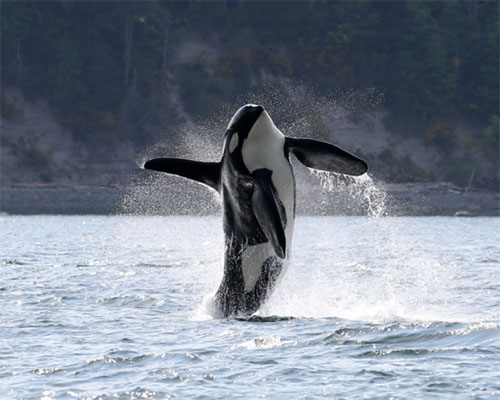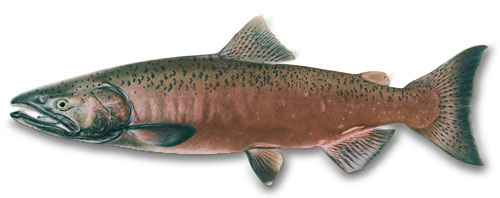— by Lin McNulty —

Endangered Southern Resident killer whales will be extinct if we don’t change our ways.
The frightening message is about as clear as it can be in a recent study published on Thursday in the peer-reviewed, scientific journal Nature: The population of our Southern Resident killer whales could show robust growth if all anthropogenic threats were removed, but has no growth under current threat levels. Anthropogenic threats (chiefly of environmental pollution and pollutants) originate from human activity. We are killing our orcas.
The critically endangered Southern Resident killer whale population of the northeastern Pacific Ocean provided a data-rich environment in which to explore human-caused threats on population viability. Results of the study published on primary threats include:
- limitation of preferred prey, Chinook salmon;
- anthropogenic noise and disturbance, which reduce foraging efficiency; and
- high levels of stored contaminants, including PCBs.

Chinook Salmon, the preferred food source for our Southern Resident killer whales, is dwindling.
Our orca population is fragile, with no growth projected under current conditions, and decline expected if new or increased threats are imposed.
As reported last month on Orcas Issues, no southern resident killer whales from any of the pods had been born alive and survived in 2017. As of 19 September, a Southern Resident killer whale, J52 – a two and a half year old male born during the so-called Baby Boom of 2015/2016 — had deceased, presumably from malnutrition.
Improvements in the ability to produce an abundance of offspring or new growth and calf survival are needed to reach a conservation objective of 2.3 percent annual population growth.
Limitation of prey is the most important factor affecting population growth. However, to meet recovery targets through prey management alone, Chinook abundance would have to be sustained near the highest levels since the 1970s.
Reducing acoustic disturbance by 50 percent, combined with increasing Chinook by 15 percent would allow the population to reach that conservative 2.3 percent growth.
The most optimistic mitigation of noise and contaminants would make the difference between a declining and increasing population, but would be insufficient to reach recovery targets.
**If you are reading theOrcasonian for free, thank your fellow islanders. If you would like to support theOrcasonian CLICK HERE to set your modestly-priced, voluntary subscription. Otherwise, no worries; we’re happy to share with you.**









Is it just maybe time to quit “watching” them???? They don’t owe us any income….
There must be something we can do. Don’t know whether to think that we can help breed more orcas in the wild? As SeaWorld comments on not breeding orcas into any of their parks. Maybe they can help to save the wild orcas and breed them
If it’s for the best interests of the orcas, watching the whales from the shore should be the only acceptable acoustic activity – the whale watching boats and private-boat watchers are loving them to death. The physical distance rule means nothing acousticallly. How would you like to try to eat, sleep, socialize and move around your home living space, closely followed by a horde of noisy boats?
I have friends who come to the San Juans because they “love” the orcas and the idea that they are here. What forms should that love take? Obviously the income derived from whale watching creates an interest group that will not be easy to discourage. The present entrepreneurs are honoring the limits given them, but these are not enough. Perhaps a more limited number of licenses for public whale watching boats (American and Canadian) ? but what to do about the 10-20 private boats that come steaming after the pros when whales appear?
Margaret is spot on. I have been an opponent of whale hunting, as I call it, might as well harpoon them rather than imped feeding.
The main problem for the whales is the chamber of commerce.
How many trees have died in studies of and plans for the whales? The one factor that is clearly critical is the supply of Chinook salmon. Why not close the Chinook fishery here and leave the salmon for the whales? What would it cost to redirect the commercial fishermen for a few years? Tinkering around the edges with factors that aren’t even established as meaningful while ignoring the starvation of the whales seems futile. This is the grimmest report to date. What is going to be done about it?
I disagree with Margaret. The current whale watch boats are NOT “honoring the limits”. We live facing the Peapod rocks and the boats are commonly within 50 feet of the rocks and the whales. We gave up reporting them years ago!